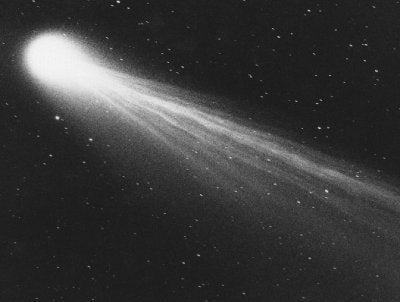What makes comets more difficult to predict than other objects in our solar system? Simply put, they change far more dramatically as they swing around the Sun in their stretched-out elliptical orbits. As a comet approaches the Sun, it gives off dust and gas from jets emanating from the comet’s nucleus. While an asteroid will always remain the same size, a comet develops a coma surrounding its nucleus that can reach hundreds of thousands of miles across. As more dust gets released into the coma, there’s more material to reflect light. In addition, the gases in the comet fluoresce, much like a fluorescent light, so a comet produces its own light.
The brightness of a comet often can be represented by the following equation:
m1 = Ho + 5 log D + 2.5n log r,
where m1 is the observed magnitude, Ho is the comet’s “absolute” magnitude, D is the distance between the comet and Earth in AU, n is a parameter that determines how fast a comet brightens as it approaches the Sun and dims as it recedes from the Sun, and r is the distance between the comet and Sun in AU. If n=2 (so 2.5n=5), this represents pure reflection. If an object doubles its distance, its brightness decreases to one-quarter its original value. If the distance is halved, it becomes four times brighter. For a comet, n is typically greater than 2 — that means the comet varies in brightness at a faster rate. Values between 2.5 and 4.5 are common. Higher values can occur, particularly for periodic comets, but not usually for a comet’s entire apparition. Astronomers now know that for long-period comets, the value of n is usually between 2.5 and 3.5. But historically, most comet predictions were based on an assumed value of n=4. So the predictions tended to unintentionally overestimate the potential brightness of long-period comets.
Great comets typically, but not always, go close to the Sun. Great comets are often, but not always, intrinsically bright. Great comets are typically, but not always, dust-rich. Dust-rich comets, particularly those with significant tails, look more impressive to the eye. It is possible, as occurred with Comet Hyakutake in 1996, that a comet becomes great simply because it approaches close to Earth. Sometimes, greatness comes as a surprise. One of our greatest comets in the past thirty years, Comet West, became great because its nucleus broke up near the Sun, exposing fresh material and dramatically increasing its intrinsic brightness.
Comets also can fizzle when they break up or, in some cases, disintegrate. When the nucleus contains no fresh ices to make the comet bright, or even hold it together, it simply dissipates in a cloud of debris. Comets from the Oort Cloud, which are new to the inner solar system, can appear very bright at large distances from the Sun because they possess lots of highly volatile ices, which turn directly to gas at very low temperatures. However, a comet’s primary component is its water ice, and the transition to water ice at 2 to 2.5 AU from the Sun sometimes leads to a significantly reduced rate of brightening.
C/1995 O1 (Hale-Bopp): Hale-Bopp was intrinsically bright because it had a very large nucleus (some 25 miles [40 kilometers] in diameter). It became a great comet despite never coming particularly close to either the Sun or Earth. And probably more people saw this comet than any other in history.
C/1996 B2 (Hyakutake): This one became great only because it approached very close to Earth. The comet also was predicted to become very bright again at perihelion, but it fizzled because it had such a tiny nucleus. Many people rate Hyakutake as the best comet of the 20th century — and perhaps even the millennium — because it passed overhead and developed an extremely long tail.
C/1975 (West): This one brightened by four magnitudes (a factor of about forty) after its nucleus broke into four pieces. West became one of the most beautiful comets of the 20th century.
C/1965 (Ikeya-Seki): This sungrazer comet was so bright it could be observed in the daytime right next to the Sun.
C/1990 (Austin): Original predictions had Comet Austin becoming very bright (magnitude -2), but the comet’s n value decreased to near zero as the comet approached the Sun. It basically stopped brightening and reached only magnitude 4.5. This is perhaps the best example of a comet fizzling.
C/1999 S4 (LINEAR): Although never expected to be a great comet, this is an excellent, recent example of a comet that simply disintegrated as it approached the Sun. Other recent examples include C/2002 O4 (Hoenig) and C/2002 O7 (LINEAR).
C/1973 (Kohoutek): Originally billed as the “Comet of the Century,” Kohoutek was a disappointment because some initial brightness forecasts assumed a much higher value of n than was appropriate. This Oort Cloud comet brightened at a fairly standard rate of n, around 2.5. Kohoutek didn’t really fizzle — the brightness projections were simply unrealistic.










